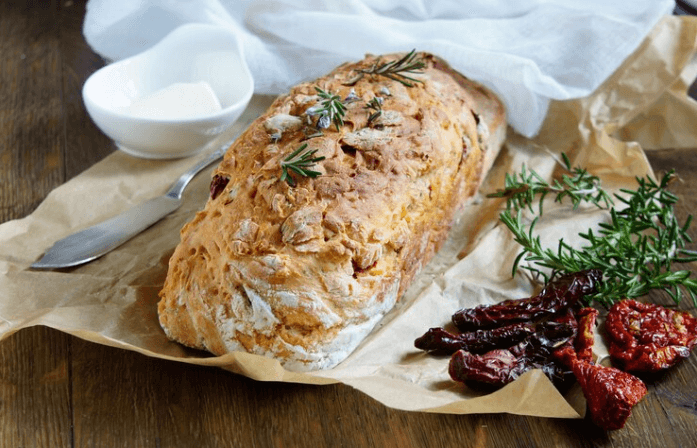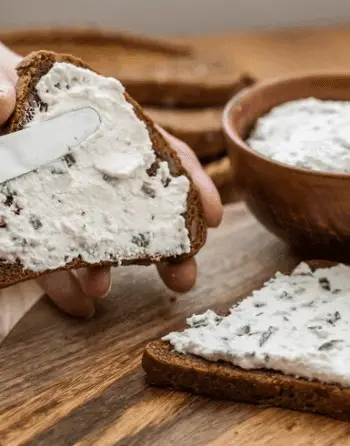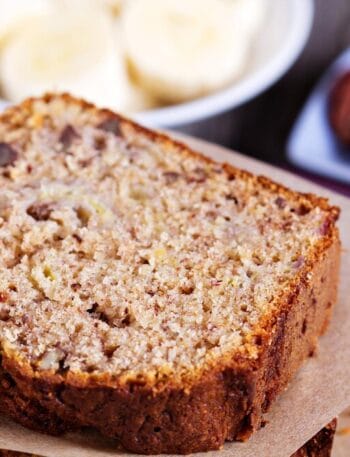Italian Bread Recipe is cherished for its crusty golden exterior and soft, airy interior, making it a timeless staple in countless households around the world. This versatile bread is the perfect companion to a variety of dishes, from hearty soups and stews to indulgent pasta meals and vibrant antipasto platters. Baking this classic bread at home not only fills your kitchen with an irresistible aroma but also allows you to customize the flavors and ensure every ingredient is fresh and wholesome. Whether you’re a seasoned baker or trying your hand at bread-making for the first time, this guide will walk you through each step, complete with tips to achieve bakery-quality results. And if you’re looking for a complementary treat, be sure to check out our recipe for an easy and creamy cinnamon roll icing here. Get ready to transform your meals with this authentic and satisfying bread!
Understanding Italian Bread Recipe
Characteristics of Italian Bread Recipe
- Crust: Thick and crispy, providing a satisfying crunch.
- Crumb: Light and airy, with irregular holes throughout.
- Flavor: Subtle, often enhanced with olive oil and sometimes a hint of sweetness.
Popular Varieties
- Ciabatta: Known for its rustic appearance and open crumb structure.
- Focaccia: A flatbread topped with herbs and olive oil, sometimes olives or tomatoes.
- Pane Toscano: A traditional Tuscan bread notable for being salt-free.
Ingredients for Authentic Italian Bread
To achieve the authentic taste and texture of Italian bread, it’s essential to use the right ingredients:
- Flour: High-quality bread flour with a protein content of around 12–13% is ideal. This ensures sufficient gluten development for that characteristic chewiness.
- Yeast: Active dry yeast or instant yeast can be used. Ensure it’s fresh for optimal rise.
- Water: Use filtered, room-temperature water to avoid any impurities that might affect fermentation.
- Salt: Enhances flavor and strengthens the gluten network.
- Olive Oil: Adds moisture and a subtle richness to the bread.
For a detailed breakdown of ingredient roles, refer to King Arthur Baking’s guide on Italian bread ingredients.
Step-by-Step Italian Bread Recipe
1. Preparing the Dough
- Mixing: In a large bowl, combine 4 cups of bread flour, 2 teaspoons of salt, and 2 teaspoons of yeast. Gradually add 1.5 cups of water and 2 tablespoons of olive oil, mixing until a shaggy dough forms.
- Kneading: Transfer the dough to a floured surface and knead for about 10 minutes until it becomes smooth and elastic. Proper kneading develops the gluten network, essential for the bread’s structure.
2. First Rise (Bulk Fermentation)
- Resting: Place the dough in a lightly oiled bowl, cover with a damp cloth or plastic wrap, and let it rise in a warm, draft-free area for 1 to 2 hours, or until doubled in size. This fermentation period allows the yeast to produce carbon dioxide, contributing to the bread’s airy crumb.
3. Shaping the Loaf
- Degassing: Gently punch down the risen dough to release excess gas.
- Shaping: Shape the dough into a loaf by flattening it into a rectangle, folding the sides inward, and rolling it tightly from the top down. Seam the edges to ensure a tight surface tension.
4. Second Rise (Proofing)
- Proofing: Place the shaped loaf onto a parchment-lined baking sheet or a floured proofing basket (banneton). Cover and let it rise for another 45 minutes to an hour, or until it has noticeably puffed up.
5. Baking
- Preheating: Preheat your oven to 450°F (232°C). Place a baking stone or an inverted baking sheet in the oven to heat up; this helps in achieving a crisp crust. Additionally, place an empty metal pan on the lower rack.
- Scoring: Just before baking, use a sharp blade or knife to make 2–3 diagonal slashes on the top of the loaf. This allows for controlled expansion during baking.
- Steaming: Pour a cup of hot water into the empty pan to create steam, which contributes to a glossy, crisp crust.
- Baking: Transfer the loaf onto the preheated stone or baking sheet and bake for 25–30 minutes, or until the crust is golden brown and the loaf sounds hollow when tapped on the bottom.
For visual guidance on the baking process, you might find this tutorial by Preppy Kitchen helpful.
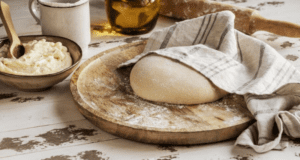
Tips for Perfect Italian Bread Recipe
- Hydration: Maintaining the correct water-to-flour ratio is crucial. A slightly sticky dough indicates proper hydration, leading to an open crumb structure.
- Fermentation Time: Avoid rushing the fermentation process. Allowing the dough to rise adequately develops flavor and texture.
- Oven Spring: Introducing steam in the initial baking phase enhances oven spring, resulting in a loftier loaf.
- Cooling: Let the bread cool completely on a wire rack before slicing. This ensures the interior sets properly and prevents a gummy texture.
Common Mistakes to Avoid
Overmixing
- Issue: Incorporating too much air can lead to a fluffy rather than smooth icing.
- Solution: Mix ingredients until just combined to maintain the desired texture.
Incorrect Consistency
- Issue: Icing that’s too thick or too thin can affect texture and application.
- Solution: Adjust consistency gradually by adding small amounts of liquid or powdered sugar as needed.
Using Cold Ingredients
- Issue: Cold butter or cream cheese can result in lumpy icing.
- Solution: Ensure ingredients are at room temperature for smoother mixing.
Skipping Sifting
- Issue: Unsifted powdered sugar may contain lumps, leading to a less smooth icing.
- Solution: Sift powdered sugar before mixing to achieve a velvety finish.
For more detailed insights on common baking mistakes, consider this resource from Allrecipes.
Storage and Shelf Life of Italian Bread Recipe
To ensure your Italian bread stays fresh and flavorful, proper storage is essential:
Short-Term Storage
- Room Temperature: Once the bread has cooled, store it in a paper bag or a bread box. This helps preserve the crust’s crispness for up to 2 days. Avoid using plastic bags, as they trap moisture and make the crust soft and soggy. For a longer shelf life, consider freezing any leftover bread (more on that below!).
Long-Term Storage
- Freezing: If you want to store Italian bread for a longer period, wrap the loaf tightly in aluminum foil or plastic wrap, then place it in a freezer-safe bag. This helps lock in freshness for up to 3 months. When you’re ready to enjoy it again, simply thaw the bread at room temperature for a few hours. To refresh the crust, reheat the loaf in the oven as mentioned earlier in this article for that just-baked taste.
Reheating Italian Bread
Reheating Italian bread properly ensures it retains its signature texture and flavor. Here are expanded techniques for the best results:
Oven Method:
- Why it works: This method mimics the bread’s original baking environment, restoring its crusty exterior and soft interior.
- Preheat your oven to 350°F (175°C).
- Lightly spritz the loaf with water to prevent it from drying out.
- Wrap the bread in foil to retain moisture and place it in the oven.
- Bake for 10–15 minutes, removing the foil for the last 2–3 minutes to achieve a crisp crust.
- Pro Tip: For extra flavor, brush olive oil or melted butter on the crust before reheating.
Microwave Method:
- Why it’s not ideal: Microwaves heat unevenly and often make bread overly soft or chewy.
- For a quick fix, place a damp paper towel over individual slices to maintain some moisture.
- Microwave on medium power for 10–15 seconds.
- Pro Tip: Combine this with a quick toast in a skillet or toaster to regain some crispiness.
Skillet Method:
- Heat a non-stick skillet over medium heat.
- Place slices or small rolls directly on the skillet.
- Cover the pan and let it heat for 1–2 minutes per side for a lightly toasted and warm result.
Serving Suggestions for Italian Bread Recipe
Italian bread is a crowd-pleaser that pairs beautifully with a wide range of meals. Here are some classic and creative ways to enjoy it:
Classic Pairings:
- Soups and Stews: Italian bread is perfect for dipping into hearty dishes like minestrone, Tuscan bean stew, or creamy tomato bisque.
- Pasta Dishes: Serve with favorites like spaghetti bolognese, lasagna, or carbonara. The bread’s sturdy texture soaks up rich sauces effortlessly.
- Antipasto Platters: Include sliced Italian bread as a base for meats, cheeses, and olives in an antipasti spread.
Creative Uses:
- Sandwiches: Use slices for panini or layer toppings like fresh tomatoes, basil, and mozzarella for a classic bruschetta.
- Bread Bowls: Hollow out a loaf to use as a bowl for soups, stews, or creamy spinach and artichoke dip.
- Garlic Bread: Spread with a mix of butter, garlic, parsley, and a touch of Parmesan before baking or broiling for a quick, crowd-pleasing side.
Dessert Option:
- For a sweet twist, use stale Italian bread to make bread pudding. Soak cubes in a mix of eggs, milk, sugar, and vanilla before baking.
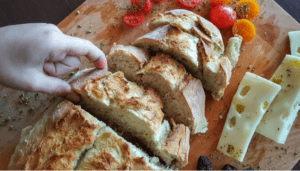
Customization Ideas
Italian bread can be tailored to suit any taste or occasion. Here’s how you can make it your own:
Flavor Additions:
- Herbs: Infuse the dough with fresh herbs like rosemary, thyme, or oregano for an aromatic loaf.
- Cheese: Mix grated Parmesan, Asiago, or Pecorino Romano into the dough or sprinkle on top before baking for added flavor.
Toppings:
- Seeds: Add texture and visual appeal with a sprinkling of sesame, poppy, or sunflower seeds before baking.
- Seasonings: Dust the crust with flavorful options like garlic powder, onion powder, or flaky sea salt for a gourmet touch.
Shape Variations:
- Roll the dough into different forms like braids, twists, or individual rolls to add variety to your table.
- Experiment with baking it in baguette-style loaves for a thinner, crispier crust.
By customizing your Italian bread, you can create a loaf that’s uniquely yours while staying true to its traditional roots.
FAQs About Italian Bread Recipe
What Makes Italian Bread Different?
Italian bread stands out due to its unique texture, ingredients, and baking process. Unlike other bread varieties, Italian bread often has:
- A soft, slightly chewy interior and a crisp, golden-brown crust.
- The use of olive oil in the dough, which adds richness and flavor.
- Simple ingredients like flour, water, yeast, and salt, with occasional inclusions like herbs, garlic, or cheese.
Italian bread is also designed to pair with traditional dishes like pasta, soups, and antipasti, making it an integral part of Italian cuisine.
What Is the Best Flour to Use for Italian Bread?
For authentic Italian bread, bread flour is the top choice because of its high protein content, which results in better gluten development and a chewy texture.
- Bread flour yields the elasticity needed for a well-structured crumb.
- If unavailable, all-purpose flour works but may produce a less chewy result.
- For rustic Italian bread, some bakers combine bread flour with semolina flour for a slightly nutty flavor.
Ensure you sift the flour to remove clumps and measure accurately for consistent results.
What Is the Difference Between French Bread and Italian Bread Recipe?
While French bread and Italian bread share similarities, they differ in several key aspects:
| Feature | French Bread | Italian Bread |
|---|---|---|
| Shape | Long and thin (e.g., baguettes) | Round or oval (e.g., ciabatta) |
| Ingredients | No fat added | Often includes olive oil |
| Crust | Thin and crisp | Thicker, more textured |
| Uses | Sandwiches, appetizers | Soups, stews, dipping |
Both breads are delicious, but Italian bread offers more versatility in flavor and texture, making it ideal for hearty meals.
What Is the Best Italian Bread?
Italy boasts an impressive variety of breads, but some are more popular and beloved:
- Ciabatta: Known for its airy crumb and slightly crisp crust, it’s perfect for sandwiches.
- Focaccia: A flatbread infused with olive oil and herbs, often topped with garlic or rosemary.
- Pane Toscano: A saltless bread with a dense crumb, traditionally paired with strong-flavored dishes.
- Grissini: Thin, crispy breadsticks often served as a starter.
Each type offers unique qualities, so the “best” Italian bread depends on your dish and preference. Whether dipping focaccia in olive oil or enjoying ciabatta with a charcuterie board, there’s an Italian bread for every occasion.
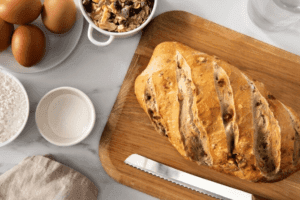
Conclusion
Making authentic Italian bread at home is a rewarding experience that combines simple ingredients with timeless techniques. With its crisp crust, soft interior, and endless versatility, this bread complements every meal, from hearty soups to elegant pasta dishes. By following the step-by-step guide, avoiding common mistakes, and experimenting with customizations, you can create a loaf that rivals any bakery.
Whether you’re preparing a special dinner, indulging in a weekend baking project, or just savoring the joy of homemade bread, this Italian bread recipe is sure to become a staple in your kitchen. And remember, the magic lies in the details—choosing fresh ingredients, mastering the kneading process, and perfecting the bake.
Ready to explore more baking adventures? Check out our Cinnamon Roll Icing Recipe for a sweet complement to your bread-making journey.

